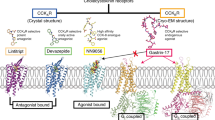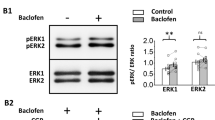Abstract
Cholecystokinin (CCK) is a neuropeptide present in the mammalian central nervous system (CNS)1. In all species studied so far, the highest concentrations of this neuropeptide have been found in the cerebral cortex, the amygdala and the hippocampus2–5. Five molecular forms of CCK having 39, 33, 13, 8 and 4 amino acid residues have been identified in the CNS, the sulphated octapeptide (CCK8) being the most abundant form detected2,6–8. Specific CCK binding sites have been demonstrated in the rat, guinea pig and human brain9,10. CCK8, applied by microiontophoresis to deep cortical neurones and hippocampal pyramidal neurones, has a powerful excitatory effect, whereas the nonsulphated CCK octapeptide has no such effect on these neurones11–16. Low doses of benzodiazepines depress the spontaneous activity of hippocampal pyramidal neurones17–20. We report here that benzodiazepines at very low doses antagonize selectively the CCK8-induced activation of rat hippocampal pyramidal neurones. This antagonistic action might be involved in the anxiolytic effect of these drugs.
This is a preview of subscription content, access via your institution
Access options
Subscribe to this journal
Receive 51 print issues and online access
$199.00 per year
only $3.90 per issue
Buy this article
- Purchase on Springer Link
- Instant access to full article PDF
Prices may be subject to local taxes which are calculated during checkout
Similar content being viewed by others
References
Morley, J. E. Life Sci. 30, 479–494 (1982).
Larsson, L. I. & Rehfeld, J. F. Brain Res. 165, 201–218 (1979).
Rehfeld, J. F. J. biol. Chem. 253, 4022–4030 (1978).
Geola, F. L. et al. J. clin. Endocr. Metab. 53, 270–275 (1981).
Vanderheagen, J.-L. INSERM Eur. Symp. 5 (eds Dumont, J. E. & Nurez, J.) 149–152 (Elsevier, Amsterdam, 1981).
Goltermann, N. R., Rehfeld, J. F. & Roigaard-Petersen, H. J. biol. Chem. 255, 6181–6185 (1980).
Goltermann, N. R., Rehfeld, J. F. & Roigaard-Petersen, H. J. Neurochem. 35, 479–483 (1980).
Goltermann, N. R., Stengaard-Pedersen, K., Rehfeld, J. F. & Christensen, N. J. J. Neurochem. 36, 959–965 (1981).
Hays, S. E., Beinfeld, M. C., Jensen, R. I., Goodwin, F. D. & Paul, S. M. Neuropeptides 1, 53–62 (1980).
Innis, R. B. & Snyder, S. H. Eur. J. Pharmac. 65, 123–124 (1980).
Oomura, Y., Otita, M., Kita, H., Ishibashi, S. & Okajima, T. in Iontophoresis and Transmitter Mechanisms in the Mammalian Central Nervous System (eds Ryall, R. W. & Kelly, J.S.) 120–123 (Elsevier, Amsterdam, 1978).
Phillis, J. W. & Kirkpatrick, J. R. Can. J. Physiol. Pharmac. 58, 337–340 (1980).
Dodd, J. & Kelly, J. S. Brain Res. 205, 337–350 (1981).
Kelly, J. S. & Dood, J. in Neurosecretion and Brain Peptides (eds Martin, J. S., Reichlim, S. & Bick, K. L.) 133–144 (Raven, New York, 1981).
Bunney, B. S., Grace, A. A., Hommer, D. W. & Skirboll, L. R. in Regulatory Peptides: From Molecular Biology to Function (eds Costa, R. & Trabucchi, M.) 424–436 (Raven, New York, 1982).
Skirboll, L. R. et al. Neuroscience 6, 2111–2124 (1981).
Adamec, R. E., McNaughton, B., Racine, R. & Livingston, K. E. Epilepsia 22, 205–215 (1981).
Lee, H. K., Dunwiddie, T. W. & Hoffer, B. J. Naunyn-Schmiedebergs Archs Pharmak. 309, 131–136 (1979).
Tsuchiya, T. & Fukushima, H. Eur. J. Pharmac. 48, 421–424 (1978).
Wolf, P. & Haas, H. L. Naunyn-Schmiedebergs Archs Pharmak. 299, 211–218 (1977).
Haigler, H. J. & Aghajanian, G. K. J. Pharmac. exp. Ther. 188, 688 (1974).
Squires, R. F. & Braestrup, C. Nature 266, 732–734 (1977).
Mohler, H. & Okada, T. Science 198, 849–851 (1977).
Hunkeler, W. et al. Nature 209, 514–516 (1981).
de Bonnel, G. & de Montigny, C. Eur. J. Pharmac. 93, 45–54 (1983).
Mohler, H., Burkard, W. P., Keller, H. H., Richards, V. G. & Haefely, W. J. Neurochem. 33, 714–722 (1981).
Braestrup, C. & Squires, R. F. Eur. J. Pharmac. 48, 263–270 (1978).
Lippa, A. S. et al. Pharmac. Biochem. Behav. 9, 853–856 (1978).
Haefely, W. & Polc, P. in Anxiolytics: Neurochemical, Behavioral and Clinical Perspectives (eds Malick, J. B., Enna, S. J. & Yamamura, H. I.) 113–145 (Raven, New York, 1983).
Author information
Authors and Affiliations
Rights and permissions
About this article
Cite this article
Bradwejn, J., de Montigny, C. Benzodiazepines antagonize cholecystokinin-induced activation of rat hippocampal neurones. Nature 312, 363–364 (1984). https://doi.org/10.1038/312363a0
Received:
Accepted:
Issue Date:
DOI: https://doi.org/10.1038/312363a0
This article is cited by
-
Brain Mechanisms Underlying Panic Attack and Panic Disorder
Neuroscience Bulletin (2023)
-
CCK and NPY as anti-anxiety treatment targets: promises, pitfalls, and strategies
Amino Acids (2006)
-
Targeted invalidation of CCK2 receptor gene induces anxiolytic-like action in light–dark exploration, but not in fear conditioning test
Psychopharmacology (2005)
-
Effects of Alprazolam on Cholecystokinin-Tetrapeptide-Induced Panic and Hypothalamic–Pituitary–Adrenal-Axis Activity: A Placebo-Controlled Study
Neuropsychopharmacology (2003)
-
Targeted mutation of CCK2 receptor gene modifies the behavioural effects of diazepam in female mice
Psychopharmacology (2003)
Comments
By submitting a comment you agree to abide by our Terms and Community Guidelines. If you find something abusive or that does not comply with our terms or guidelines please flag it as inappropriate.



